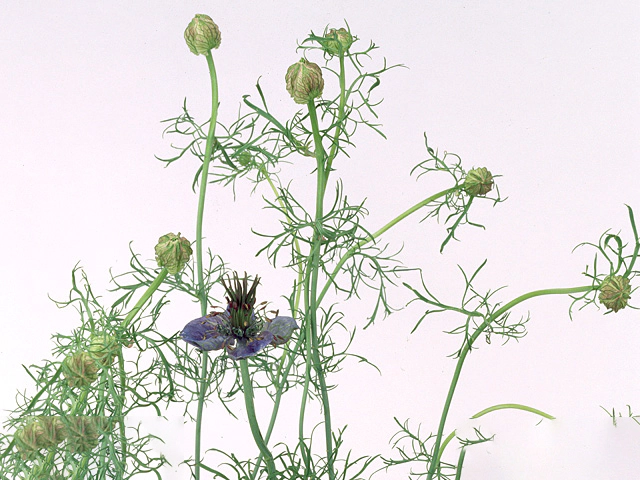Nigella hispanica

| Flower scent | Unscented |
| Leaf type | Foliage leaf |
| Flower color | Blue-dark violet blue-094A |
| Inflorescence | Single-flowered |
| Structure (tissues) | Herbaceous |
Wild fennel, scientifically known as Nigella hispanica, is a fascinating plant that boasts unique characteristics. Its delicate foliage leaf gives it a striking appearance, while its stunning flowers come in a dark violet blue hue, creating a captivating sight for nature enthusiasts.
Unlike some other flowers, wild fennel does not possess a noticeable scent. However, it compensates for this by showcasing its beauty through its foliage and flower colors. The distinct blue-dark violet blue of its blossoms adds an enchanting touch to any landscape.
When it comes to its inflorescence, wild fennel features single-flowered clusters, setting it apart from other plants. This unique trait further adds to the plant's aesthetic appeal, making it stand out in any garden or natural habitat.
Structure-wise, wild fennel is characterized as herbaceous, meaning it has soft, green tissues. This makes it flexible and easily adaptable to different growing conditions.
Wild fennel is native to the Iberian Peninsula, but it can also be found in other parts of the world. It flourishes in regions with temperate climates and is often used in horticulture due to its attractive features.
Aside from its visual appeal, Nigella hispanica also has various practical uses. Its seeds are commonly used in culinary applications, particularly in Mediterranean cuisine. The seeds have a distinct flavor that adds a unique taste to dishes, and they are often included in salads, bread, and pickles.
Furthermore, wild fennel has historically been used in traditional medicine for its potential health benefits. It contains essential oils and antioxidants that may have anti-inflammatory and digestive properties. Some people also use it to alleviate symptoms of menopause, such as hot flashes and hormonal imbalances.
Moreover, wild fennel has cultural significance in different societies. It has been used in folklore, herbal remedies, and even as an ingredient in perfumes and cosmetics. Its vibrant blue flowers are often associated with symbolism, representing tranquility, peace, and harmony.
Growing wild fennel can be a rewarding experience for gardening enthusiasts. It is relatively easy to cultivate, and its attractive features make it an eye-catching addition to any garden. It thrives in well-drained soil and requires moderate watering and sunlight.
In conclusion, Nigella hispanica, or wild fennel, is a captivating plant that showcases its beauty through its foliage leaf and stunning dark violet blue flowers. While it may lack a noticeable scent, its aesthetic appeal compensates for that. Apart from its visual charm, wild fennel also has practical uses in cooking and traditional medicine. Whether in horticulture, cooking, or cultural traditions, this herbaceous plant holds its importance and continues to charm us with its unique qualities.
Market availability index by month:
| Jan. | Feb. | Mar. | Apr. | May | Jun. | Jul. | Aug. | Sep. | Oct. | Nov. | Dec. |
|---|---|---|---|---|---|---|---|---|---|---|---|
| - | - | 2 | 3 | 4 | 3 | 2 | 2 | 1 | 1 | - | - |